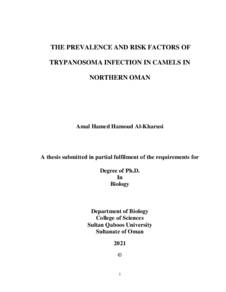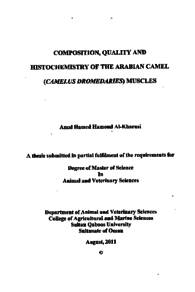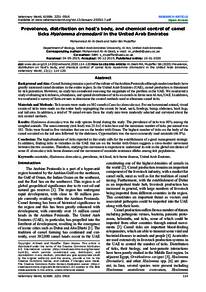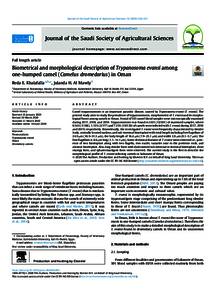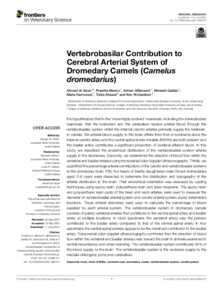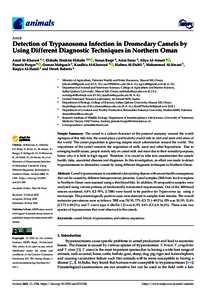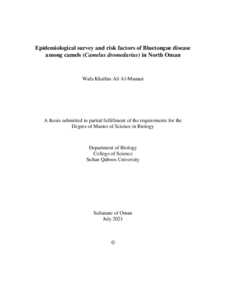وثيقة
The Prevalence and risk factors of trypanosoma infection in camels in Northern Oman.
الناشر
Sultan Qaboos University.
ميلادي
2021
اللغة
الأنجليزية
الموضوع
الملخص الإنجليزي
Active and passive data collections were conducted as a preliminary study in this research aimed
to investigate the seroprevalence of Trypanosoma evansi and its associated risk factors in
dromedary camels in North Ash Sharqiya governorate in the Sultanate of Oman. A total of 4364
serum samples was collected in a period between July 2014 to November 2015 from three
willayat in north governorates of Sultanate of Oman; Ibra (926, 21.2%), Qabil (1119, 25.6%) and
Bidiyah (2319, 53.1%). Samples were examined for the presence of antibodies against T. evansi
using card agglutination test (CATT/T. evansi). Binary logistic regression was used to study the
association of T. evansi seroprevalence and risk factors such as location, gender, purpose and age
of camels. The overall seroprevalence of T. evansi detected by CATT/T. evansi test was 38%
(1659/4364, CI: 36.6-39.5%). There was a significant difference (p=0.001) between location and
T. evansi seroprevalence, whereas highest seroprevalence was found in Ibra (49.9%, CI: 46.7-
53.1%) followed by Bidiyah (35%, CI: 33-36.9%) and Qabil (34.5%,CI: 31.8-37%). Camels from
Ibra were almost two times more likely to have circulating antibodies of T. evansi than camels
from Bidiyah (OR=1.89, CI: 1.591-2.168). Also, the results showed a significant difference
between seroprevalence and sex (p=0.023), whereas the age of camels was not (p>0.05).
For active data collection, a new 388 blood samples from dromedary camels in the Northern of
Oman was collected to investigate the current condition of the disease by using different
diagnostic techniques. Serum samples were examined using CATT/T.evansi test to determine the
effect of risk factors on the prevalence of T. evansi. Blood samples examined using
haematological parameters were also assessed. The model of binary logistic regression was used
to examine the association of T.evansi seroprevalence with potential risk factors such as location,
age, sex, camel mixed with other animals, deworming, tick presence, prophylaxis usage, vector
control and abortions. The overall seroprevalence of T.evansi was 26.3% (102/388). There is a
significance difference between disease seroprevalence and location (x
2=11.99, p=0.017). Camels
younger than four years old were 3.79 times more likely to have circulating antibodies against T.
evansi than camels aging between four to ten years old. The mean MCV (mean corpuscular
volume) and eosinophil count in the naturally infected camels were significantly lower than non infected one.
All camel samples (388) from the five regions in Northern of Oman were assessed by thin blood
film. In addition, 95 seropositive samples were analysed by molecular test (RoTat1.2, EVAB,
TvPRAC, ITS-1, TBR). Out of the 388 blood smear examined, 0.8% (2/388) were positive for
trypanosomiases using microscope. The parasitological positive cases were detected from female
samples. The overall molecular prevalence of TBR was 78/95, 77% (Cl 73.1-89.2%), ITS was
30/95, 31.6% (Cl 73.1-89.2%), T. evansi type A (RoTat1.2) was 8/95, 8.4% (Cl 4.0-16.0%), T.
vivax was also detected in 41/95, 31.6% (Cl 73.1-89.2%). T. evansi Type A was detected in eight
samples from Al Buraimi, AlBatinah, Dakhiliyah and Ash Sharqiyah.
In this study, 18 DRA exon 2 sequences out of 60 samples was amplified and sequenced from sick
and healthy camels from Oman. About 18 sequences belonged to one haplotype (Genbank:
KT936411)one sequence of them is (J16) is heterozygous for KT936410. The sequence was
simplified in this study were identical to sequences of dromedaries camels originating from Jordan
and Australia. The Cadr-DRA haplotypes are shared between the three species (dromedary,
Bactrian, wild two-humped camel). This findings indicated a low diversity of DRA exon 2 gene
in the dromedary camels examined in the country.
To our knowledge, this is the first research that indicated that T. evansi antibodies were circulating
among camels in Oman, and further research needs to be tackled to study the molecular
characterization of T. evansi and its prevalence in other animal species. Further research is
required to investigate the species of trypanosomes and the type of flies, which transmitted the
disease. The study indicates that trypanosoma can effect camels from different age, sex and
regions. T. evansi is not the only species that observed in camels. The T. vivax is the first to be
reported in the Middle East and require extended research in the southern regions of Oman.
المجموعة
URL المصدر
قالب العنصر
الرسائل والأطروحات الجامعية

